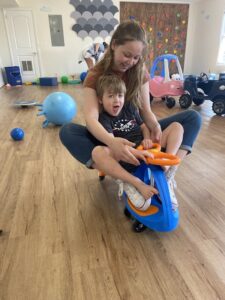What is Autism?

Autism defined
Autism is a “neurological developmental” disability, meaning it impacts brain development and growth, develops early in life, and is a chronic condition. Autism is usually evident in children before the age of three.
The exact cause of autism is not yet known, but researchers do know genetics sometimes plays a role in the onset of autism. They also believe there is a complex interaction of factors that result in the development of autism, which is why it has been so difficult to pinpoint exactly what causes the disability.
 Signs of autism
Signs of autism
Individuals are diagnosed with autism when they do not have the developmentally appropriate skills or “on target” development in the areas of social interaction, verbal communication and nonverbal communication as others of their same chronological age. For example, children with autism may not begin talking on their own or may only use single words instead of learning how to create phrases or sentences. Some children with autism seem to be unaware of others around them, and others with autism may attempt to interact or play with children but do not do so in a typical way.
To be diagnosed with autism, an individual also must engage in repetitive behavior and/or restricted interests that are not common for someone of their age. Repetitive behavior may look like often wiggling their fingers in front of their eyes, or it could look like flipping a light switch over and over. Individuals with autism may have obsessions with one particular topic, like cars or insects, and prefer to always talk about and engage in activities related to that interest.
No two children with autism are the same. Autism impacts brain development differently in every individual diagnosed with autism, so symptoms and characteristics are uniquely different in every child. The severity of autism also varies with each individual, and typically the diagnosing clinician will assign a level of autism, with level 1 being “least severe” and level 3 being the “most severe” with autism impacting all areas of development.
Some children with autism begin to develop skills and then “regress,” or lose those skills, and other children with autism do not develop age-appropriate skills without therapeutic intervention.
Is there a “cure” for autism?
There is no cure for autism and no medication to prevent or reverse the condition. Unfortunately, some people claim to have cures through obscure remedies such as very restricted diets or interventions with animals but there is no data or evidence showing the intervention has an impact on reducing the severity of autism or curing it all together. This makes it difficult for parents and caregivers of individuals with autism to know how to help their loved one or who to trust with creating an intervention plan.
Autism and ABA
As with other developmental disabilities, such as cerebral palsy or ADHD, there is effective, evidence-based treatment available to reduce the severity of autism and the life-long impact it has on an individual’s life. The only research-based treatment proven to address autism symptoms are interventions in the scientific discipline of Applied Behavior Analysis (ABA).
ABA interventions include making changes in the immediate environment, not in the individual, to support the learning of different behavioral responses. ABA interventions also include special teaching strategies to teach developmentally appropriate skills, therefore reducing the gap between the individual’s skillset and the skillset of neurotypical peers their age. ABA is also effective because the intervention is individualized to each person’s needs, which makes it incredibly useful for the treatment of autism since each child with autism is unique.

Effectiveness of ABA
Applied Behavior Analysis’s effectiveness on the treatment of autism has been studied since the 1940s. An abundance of research shows ABA’s effectiveness in reducing inappropriate behavior, dangerous and injurious behaviors, and teaching of new skills including verbal communication, self-help skills, motor skills, social skills, and academic skills. As with any scientific discipline, ABA has evolved over the decades as researchers learn new and better interventions to ethically and effectively treat those diagnosed with autism.
ABA services are now covered as a medically necessary treatment by insurance companies as it is mandated by state law due to its treatment effectiveness.
Hope for kids with autism
Autism is not a hopeless condition, and individuals diagnosed with autism can live their lives safely, functionally, and joyfully. Through early diagnosis and early access to effective ABA treatment, children impacted by autism can make great developmental strides and live a life of happiness.
At JoyBridge Kids, our passionate, experienced clinicians provide the effective ABA treatment that can result in children with autism living joyfully and functionally throughout their lifespan.

 Signs of autism
Signs of autism